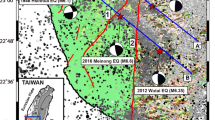Abstract
Late Miocene shortening rate, uplift rate, and inversion rate in the central inversion zone of the Xihu (西湖) depression, East China Sea basin, were independently determined from a large number of 2D reflection seismic data and methods. Shortening rate was estimated from the 2DMOVE balanced cross-section technology, uplift rate was calculated after absolute erosions were determined from seismic data during the uplifting time, and inversion rate was measured using the improved calculation method by Song (1997). The cross correlations among shortening rate, uplift rate, and inversion rate show a good positive relationship, with some differences existing in local areas. This article analyzes the cross correlation between these structural rates and discusses the dynamics of mechanisms for basin inversion and their influence on hydrocarbon accumulation.
Similar content being viewed by others
References Cited
Brun, J. P., Nalpas, T., 1996. Graben Inversion in Nature and Experiments. Tectonics, 15: 677–687
Cecil, M. R., Mihai, N. D., Peter, W. R., et al., 2006. Cenozoic Exhumation of the Northern Sierra Nevada, California, from (U-Th)/He Thermochronology. GSA Bull., 118: 1481–1488
Chen, Z. Y., Ge, H. P., 2003. Inversion Structures and Hydrocarbon Accumulation in Xihu Sag, East China Sea Basin. China Offshore Oil and Gas (Geology), 17(1): 20–24 (in Chinese with English Abstract)
Cooper, M. A., Williams, G. D., de Graciansky, P. C., et al., 1989. Inversion Tectonics—A Discussion. In: Cooper, M. A., Williams, G. D., eds., Inversion Tectonics. Geol. Soc. London, Spec. Publ., 44: 335–347
Dewey, J. F., 1986. Kinematics and Dynamics of Basin Inversion. In: Cooper, M. A., Williams, G. D., eds., Inversion Tectonics. Geol. Soc. London, Spec. Publ., 44: 352
Kossow, D., Krawczyk, C. M., 2002. Structure and Quantification of Processes Controlling the Evolution of the Inverted NE-German Basin. Marine and Petroleum Geology, 19:601–618
Letouzey, J., Werner, P., Marty, A., 1990. Fault Reactivation and Structural Inversion, Backarc and Intraplate Compressive Deformations: Example of the Eastern Sunda Shelf (Indonesia). Tectonophysics, 183: 341–362
Li, C. F., Zhou, Z. Y., Ge, H. P., et al., 2007. Correlations between Erosion and Relative Uplifts from the Central Inversion Zone of the Xihu Depression, East China Sea Basin. Terr. Atmos. Ocean. Sci., 18: 757–776
Li, S. Q., 2000. Cenozoic Basin Geological Tectonic Feature and Evolution in Xihu Trough, the East China Sea. Offshore Oil, 104(2): 8–14 (in Chinese with English Abstract)
Liu, J. Y., Lin, C. S., Jiang, L., et al., 2000. Characteristics of Tertiary Inversion Structures and Their Influence on Oil-Gas Accumulation in Xihu Trough, East China Sea. Acta Geoscientia Sinica, 21(4): 350–355 (in Chinese with English Abstract)
Midland Valley Exploration, 1999. Computer Aided Structural Balancing and Restoration with 2DMOVES. Midland Valley Training Course. Midland Valley, UK.
Pederson, J. L., Mackley, R. D., Eddleman, J. L., 2002. Colorado Plateau Uplift and Erosion Evaluated Using GIS. GSA Today, 12: 4–10
Riebe, C. S., Kirchner, J. W., Granger, D. E., et al., 2000. Erosional Equilibrium and Disequilibrium in the Sierra Nevada, Inferred from Cosmogenic 26Al and 10Be in Alluvial Sediment. Geology, 28(9): 803–806
Shang, K. Y., Jia, J. Y., Zhou, Z. Y., et al., 2001. Quantitative Estimation of Erosion for Xihu Depression: Sonic Velocity Analysis. Offshore Oil, 109: 12–15 (in Chinese with English Abstract)
Song, T. G., 1997. Inversion Styles in the Songliao Basin (Northeast China) and Estimation of the Degree of Inversion. Tectonophysics, 283: 173–188
Spotila, J. A., 2005. Applications of Low-Temperature Thermochronometry to Quantification of Recent Exhumation in Mountain Belts. Rev. Mineral. Geochem., 58: 449–466
Turner, J. P., Williams, G. A., 2004. Sedimentary Basin Inversion and Intraplate Shortening. Earth-Science Reviews, 65:277–304
Wang, G. M., Coward, M. P., Yuan, W. G., et al., 1995. Fold Growth during Basin Inversion—Example from the East China Sea Basin. In: Buchanan, J. G., Buchanan, P. G., eds., Basin Inversion. Geol. Soc. London, Spec. Publ., 88:493–522
Williams, G. D., Powell, C. M., Cooper, M. A., 1989. Geometry and Kinematics of Inversion Tectonics. In: Cooper, M. A., Williams, G. D., eds., Inversion Tectonics. Geol. Soc. London, Spec. Publ., 44: 3–15
Wobus, C., Heimsath, A., Whipple, K., et al., 2005. Active Out-of-Sequence Thrust Faulting in the Central Nepalese Himalaya. Nature, 434: 1008–1011
Yamada, Y., McClay, K., 2004. 3-D Analog Modeling of Inversion Thrust Structures. In: McClay, K. R., ed., Thrust Tectonics and Hydrocarbon Systems. AAPG Memoir, 82:276–301
Yang, S. H., Hu, S. B., Cai, D. S., et al., 2004. Present-Day Heat Flow, Thermal History and Tectonic Subsidence of the East China Sea Basin. Marine and Petroleum Geology, 21: 1095–1105
Zhao, J. H., 2004. The Forming Factors and Evolvement of the Mesozoic and Cenozoic Basin in the East China Sea. Offshore Oil, 24(4): 6–14 (in Chinese with English Abstract)
Zhou, Z. Y., Jia, J. Y., Li, J. B., et al., 2002. Quantitative Study on Inversion Structures in Xihu Depression, East China Sea Constraints from Fission Track Analysis Data. Marine Geology & Quaternary Geology, 22(1): 63–67 (in Chinese with English Abstract)
Author information
Authors and Affiliations
Corresponding author
Additional information
This study was supported by 863 National High-tech Research and Development Major Projects of China (No. 2006AA09A101), and CNOOC China Limited.
Rights and permissions
About this article
Cite this article
Yang, F., Yu, H., Zhang, Q. et al. Correlations between shortening rate, uplift rate, and inversion rate in central inversion zone of Xihu depression, East China Sea basin. J. Earth Sci. 20, 699–708 (2009). https://doi.org/10.1007/s12583-009-0056-6
Received:
Accepted:
Published:
Issue Date:
DOI: https://doi.org/10.1007/s12583-009-0056-6




